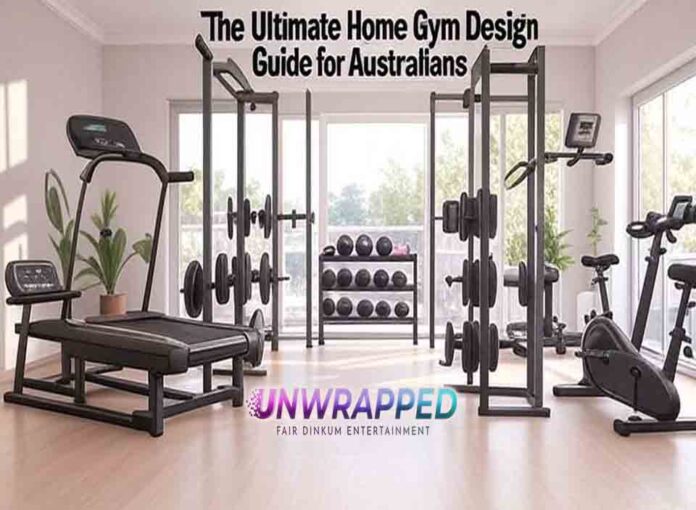At-home fitness is growing fast in Australia. With rising gym costs and busy schedules, many Australians now prefer the flexibility of working out at home. A home gym eliminates travel time, reduces distractions, and gives full control over your fitness journey.
This blog helps you build a space that delivers real results. You will learn about designing a gym that works with your routine, matches your lifestyle, and feels good to use.
Planning: Start With the Right Foundation
A. Define Your Fitness Goals
What do you want from your workouts?
If you aim to lose weight, focus on cardio tools and fat-burning routines. A treadmill, spin bike, or jump rope can help. If you want strength, consider dumbbells, resistance machines, or a barbell set. For flexibility, ou’ll need mats, space for movement, and maybe a yoga block or wheel. For all-around fitness, combine strength, mobility, and cardio zones.
Your goals shape your space. They decide what equipment fits and how much room you need. Keep them clear and realistic, as this makes every design decision easier.
B. Measure and Evaluate Space
Look at available spaces in your home. A garage, spare room, outdoor patio, or even a quiet corner in your living room could work. Check the room size. Make sure there’s enough ceiling height for lifting and jumping. Ventilation also matters. You’ll sweat. Airflow keeps your space comfortable and fresh. If the room lacks windows, consider a standing fan or air filter.
C. Set Your Budget Early
Budgeting helps you avoid surprises. Break costs into three parts: essentials, aesthetics, and upgrades.
Essentials cover equipment you’ll use every day. These come first. Aesthetics include flooring, mirrors, lights, and paint. Upgrades include tech add-ons or premium gear. Know where to spend and where to save.
Always leave a buffer. Gym flooring and mirrors often cost more than expected. Plan ahead to avoid cutting corners.
Smart Equipment Selection for Functionality
A. Must-Haves for Small Spaces
Limited space doesn’t mean limited results. Foldable benches store easily and work well for full-body training. Adjustable dumbbells replace entire racks. Resistance bands add versatility and take zero floor space. Wall-mounted cable systems deliver dozens of exercises without hogging room.
B. Essentials for Larger Setups
With more space, go big on impact. Add a power rack for safe lifting. Use it for squats, presses, and pull-ups. Combine it with an Olympic barbell and bumper plates. Include a cardio machine, treadmill, elliptical, or rower, depending on your preference.
Turf or sled tracks boost functional training. Great for sprints, lunges, or sled pushes. These tools turn your home gym into a complete training zone.
C. Build Around Versatility and Goals
Every item must earn its spot. Choose home gym equipment that adapts to your training needs. A squat rack with pull-up bars. A bench that inclines, declines, and folds. Cable machines that adjust to different angles.
Layout Optimization for Flow and Safety
A. Zoning the Room for Activities
A good layout boosts results. Create zones. One for cardio. One for weights. One for stretching or core work. This setup mirrors professional gyms and makes transitions easy.
Clear zoning also improves focus. You won’t mix heavy lifting with yoga or HIIT in the same corner. It brings order and balance.
B. Positioning for Safety and Use
Leave enough space around each machine or station. Place mirrors where you can watch your form. Avoid blocking windows or doors.
Use rubber mats to anchor stations. Add floor markers if needed. They guide your footwork and prevent slipping.
C. Storage That Boosts Function
Clutter kills motivation. So, install vertical racks to hold barbells, plates, and mats. Use wall hooks for jump ropes or bands. Store small items in under-bench bins. Keep towels and cleaning wipes in reach.
Designing for Aesthetic Appeal
A. Color Psychology in Home Gyms
Colors shape mood in home gyms. Use red or orange to energize. These shades trigger action. Use blue or green to calm the mind. Great for yoga or recovery spaces.
Match your wall color with your gear. A black power rack against a bold wall adds contrast. Light tones create an open, airy vibe. Avoid dull or mismatched palettes.
B. Mirrors and Lighting
Mirrors serve two purposes. They help you fix your form. They also make rooms feel bigger and brighter. Place them across from light sources for best effect.
Use layered lighting. Overhead LEDs for visibility. Soft side lights for mood. Highlight mirrors, posters, or your favorite corner.
C. Add Your Style
Make the space yours. Add motivational posters or wall quotes. Choose ones that reflect your goals. Include indoor plants as they clean the air and freshen the vibe. Install a small sound system to keep the energy high.
Build Your Dream Gym with Confidence
Now you know what it takes to build a home gym that performs well and looks great.
Start with your goals. Choose your space wisely. Pick versatile equipment. Design zones that keep workouts efficient. Style it to match your energy and personality.
If you are ready to build yours, explore top-rated home gym equipment at Dynamo Fitness. Visit our website or stop by one of our Australian stores today. Our experts are here to help you design the gym you’ll love, every single day.










